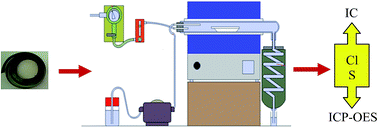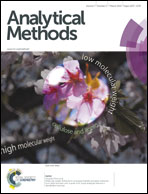Determination of chlorine and sulfur in high purity flexible graphite using ion chromatography (IC) and inductively coupled plasma optical emission spectrometry (ICP OES) after pyrohydrolysis sample preparation
Abstract
The pyrohydrolysis method was applied for digestion of high purity flexible graphite (FG) used in nuclear applications and subsequent determination of Cl and S was performed by inductively coupled plasma optical emission spectrometry (ICP OES) and ion chromatography (IC). Instrumental parameters for pyrohydrolysis were studied such as reaction time, air and water flow-rates pumped through the reactor, the type and concentration of absorbing solution (water, 10 to 200 mmol L−1 NH4OH or 100 to 1000 mmol L−1 H2O2) and the use of V2O5 as an accelerator. Sample masses up to 250 mg were decomposed using pyrohydrolysis at 1100 °C for 30 min. Quantitative recoveries of Cl and S were obtained using air and water flow-rates pumped through the reactor at 0.1 L min−1 and 0.5 mL min−1, respectively, without the use of V2O5. Absorbing solution of 50 mmol L−1 NH4OH and 250 mmol L−1 H2O2 was suitable for quantitative absorption of Cl and S. The limit of detection (LOD) was 1 μg g−1 for Cl determination by IC that was 20-fold better than that obtained by ICP OES. In this sense, IC determination is recommended for Cl determination in FG in order to meet the General Electric (GE) recommendations for nuclear materials. On the other hand, LODs obtained for S using IC and ICP OES were similar (1 μg g−1). For S determination by IC, the absorbing solution should be H2O2 in order to convert all S species to SO42−. For comparison, Cl and S were also determined in digests obtained using microwave-induced combustion (MIC). In spite of high chemical inertness that allowed combustion of only 25 mg of FG, the statistical difference between pyrohydrolysis and MIC results was not observed. Evaluation of accuracy was carried out using certified reference materials (NIST 1632c – bituminous coal and SARM 19 coal) and significant differences were not observed between certified reference values and pyrohydrolysis results. After optimizing conditions, pyrohydrolysis was suitable for quality control of Cl and S impurities in FG used for nuclear applications.


 Please wait while we load your content...
Please wait while we load your content...